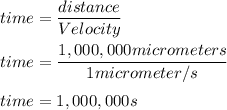
Neurons have long, thin processes called axons, which are structures specialized for conducting signals throughout the organism's nervous system. some axonal processes, such as the axons that originate in the spinal cord and terminate in the muscles of the toes, can be over 1 m in length. small membrane‑enclosed vesicles carrying materials essential to axonal function move along microtubules of the cytoskeleton, from the cell body to the tips of the axons. given an average vesicle velocity of 1 μm/s, how long would it take for a vesicle to move through an axon that started in the spinal cord and ended in the toes (a distance of 1 m)?

Answers: 2


Another question on Biology

Biology, 21.06.2019 14:00
What adaptation is apparent in the bodies of the three tortoise species shown in figure 16-2
Answers: 3


Biology, 21.06.2019 20:00
Chlorophyll is found in plant leaves and absorbs light from the sun to enable plants to perform photosynthesis. magnesium is an important component of chlorophyll. the concentration of magnesium ions is higher in the root-hair cells of plants than in the soil. which mechanism of ion uptake would best enable a plant to produce a steady supply of chlorophyll? osmosis diffusion passive transport active transport
Answers: 1

Biology, 21.06.2019 21:50
What is the name for a substance formed in a chemical reaction
Answers: 1
You know the right answer?
Neurons have long, thin processes called axons, which are structures specialized for conducting sign...
Questions


Mathematics, 18.03.2020 19:37

Mathematics, 18.03.2020 19:37



Biology, 18.03.2020 19:37



History, 18.03.2020 19:38





Mathematics, 18.03.2020 19:38




History, 18.03.2020 19:39

Mathematics, 18.03.2020 19:39






